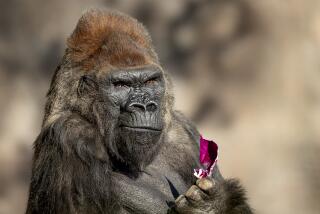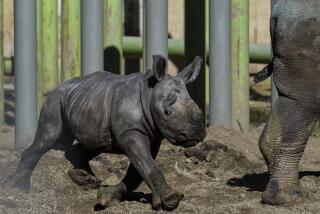Dinka, Rhino at Animal Park, Dies : Zoology: Officials suspect that old age of northern white rhinoceros, an endangered species, caused his death.
- Share via
Dinka, an endangered northern white rhinoceros and one of fewer than 35 left in captivity, has died at the San Diego Wild Animal Park, possibly of old age, a park spokesman said Tuesday.
Preliminary findings from a necropsy revealed that Dinka suffered a ruptured spleen within 48 hours before his death Monday morning, but they did not conclude it was the immediate cause of death, said park spokesman Tom Hanscom. Early test results also showed no sign of disease, although the animal had been exhibiting ill health and poor appetite in the past couple of weeks, he said.
However, Hanscom described Dinka, at least 40 years old, as “simply a very old rhino and on his way out.” More tests will be conducted in the next week to determine the exact cause of death, he said.
A repairman making his rounds on the monorail noticed Dinka about 6:30 a.m. Sunday lying down against the chain link fence of his pen. Another male northern white rhinoceros, Saut, was standing outside the pen, uncharacteristicly close for these fiercely territorial animals, Hanscom said.
Park keepers speculate that, after Dinka collapsed in his pen, he was struck through the fence by Saut’s horn, Hanscom said. Dinka was in the special isolation pen within the rhino enclosure because of a fight he had with Saut two months ago, Hanscom said.
“Dinka was still in the catch pen, separated from the other rhinos in the North Africa exhibit,” Hanscom said. “There have been no problems for the past two months.”
Keepers found Dinka in a semi-comatose state, in shock and slightly dehydrated, he said. Veterinarians gave Dinka an intravenous glucose drip to boost his low fluid level and covered him with several electric blankets charged by a portable generator to treat his shock, Hanscom said.
Vets stayed with Dinka overnight until he stopped breathing about 6:30 a.m. Monday, Hanscom said.
Since the fight two months ago and Dinka’s subsequent placement in the isolation pen, keepers observed the rhino’s lack of appetite and listlessness, Hanscom said. Although no actual weight loss was recorded, the necropsy noted “no appreciable fat stores,” he said.
“We would assume that a rhino would have a great deal of fat stored in the tissue, and he did not,” Hanscom said. “He was obviously becoming a bit malnourished, but wild animals mask infirmity extremely well, and often you don’t know an animal is sick until he literally drops dead.”
Dinka was captured as an adult in the wilds of the Sudan in 1953, Hanscom said. He was brought to a zoo in the Sudan before being moved to the St. Louis Zoo in 1957, then the San Diego Zoo in 1972 and finally the Wild Animal Park in October, 1982.
In addition to the four remaining northern white rhinos at the park, there are seven rhinos at a zoo in Dvur Kralove, Czechoslovakia, and an estimated 20 in the Garamba National Park in northern Zaire, Hanscom said. No northern white rhinos are believed to exist in the wild, he said.
The northern white rhinoceros, which numbered in the thousands throughout North Africa two decades ago, was poached to the point of extinction for its valuable horns, Hanscom said. Of the five species of rhinoceros, the northern white is among the four species on the endangered list.
The horns were smuggled through the black market to Asia, where they were ground into powder and used as an aphrodisiac, Hanscom said. In Yemen, the horns were carved into dagger handles and presented to a young man as part of a rite of passage.
The Northern white is the largest rhinoceros in the world, averaging about 6,000 pounds, but able to reach as much as 4 tons, Hanscom said. The animal is distinguished by its wide upper lip and is not white, he said.
Attempts to breed Dinka with the two female rhinos the park received in 1989 were not successful, Hanscom said. A sample of Dinka’s sperm is being kept cryogenically frozen at the Center for the Reproduction of Endangered Species until the technology becomes available to artificially inseminate a rhinoceros, he said.
Attempts to breed the other northern white rhinoceros have also been unsuccessful, Hanscom said.
More to Read
Sign up for Essential California
The most important California stories and recommendations in your inbox every morning.
You may occasionally receive promotional content from the Los Angeles Times.













